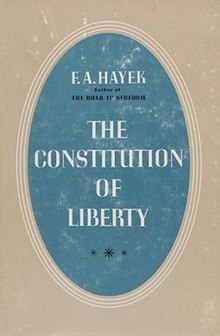The Constitution of Liberty
 First edition dust jacket | |
| Author | Friedrich Hayek |
|---|---|
| Country | United States |
| Language | English |
| Subject | Politics, Economics |
| Publisher | University of Chicago Press (US) |
Publication date | 1960 |
| Media type | |
| Pages | 576 |
| ISBN | 0-226-32084-7 |
| Part of a series on |
| Libertarianism |
|---|
|
The Constitution of Liberty is a book by Austrian economist and Nobel Prize recipient Friedrich A. Hayek. The book was first published in 1960 by the University of Chicago Press. It is an interpretation of civilization as being made possible by the fundamental principles of liberty, which the author presents as prerequisites for wealth and growth, rather than the other way around.
The Constitution of Liberty was notably held up at a British Conservative Party policy meeting and banged on the table by Margaret Thatcher, who reportedly interrupted a presentation to indicate, in reference to the book, that "This is what we believe".[1][2][3]
Book[]
- 1960. The Constitution of Liberty, University of Chicago Press. ISBN 0226320847
- 2011. The Constitution of Liberty: The Definitive Edition, Ronald Hamowy, ed., v. 17, The Collected Works of F A. Hayek. University of Chicago Press.
Contents[]
Part I – The Value of Freedom
1. Liberty and Liberties
2. The Creative Powers of a Free Civilization
3. The Common Sense of Progress
4. Freedom, Reason, and Tradition
5. Responsibility and Freedom
6. Equality, Value, and Merit
7. Majority Rule
8. Employment and Independence
Part II – Freedom and the Law
9. Coercion and the State
10. Law, Commands, and Order
11. The Origins of the Rule of Law
12. The American Contribution: Constitutionalism
13. Liberalism and Administration: The Rechtsstaat
14. The Safeguards of Individual Liberty
15. Economic Policy and the Rule of Law
16. The Decline of the Law
Part III – Freedom in the Welfare State
17. The Decline of Socialism and the Rise of the Welfare State
18. Labor Unions and Employment
19. Social Security
20. Taxation and Redistribution
21. The Monetary Framework
22. Housing and Town Planning
23. Agriculture and Natural Resources
24. Education and Research
Postscript: Why I am Not a Conservative
Reception[]
The Constitution of Liberty was placed 9th on the list of the 100 best non-fiction books of the twentieth century compiled by the biweekly conservative magazine National Review.[4]
References[]
- ^ Berlinski, Claire (December 22, 2011). "Five myths about Margaret Thatcher". The Washington Post.
- ^ Mcdonough, John E. (May 22, 2021). "The Tortured Saga of America's Least-Loved Policy Idea". POLITICO. Retrieved 2022-01-31.
- ^ Feser, Edward (January 28, 2007), "Introduction", The Cambridge Companion to Hayek, Cambridge University Press, pp. 1–12, doi:10.1017/ccol0521849772.001, ISBN 978-0-521-84977-7, retrieved 2022-01-31
- ^ The Editors (3 May 1999). "The Non-Fiction 100". National Review.
{{cite news}}:|last1=has generic name (help)
External links[]
 Quotations related to The Constitution of Liberty at Wikiquote
Quotations related to The Constitution of Liberty at Wikiquote
- 1960 non-fiction books
- Books about capitalism
- Books by Friedrich Hayek
- Conservatism
- University of Chicago Press books